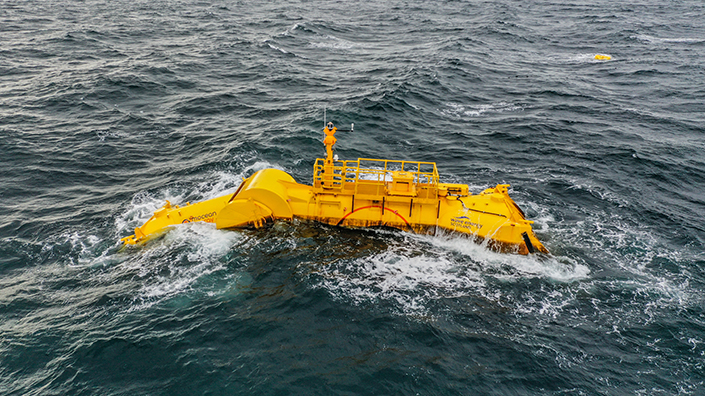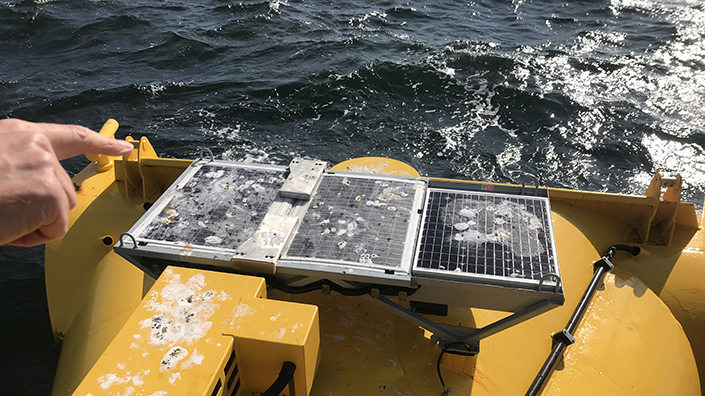Several companies, testing their cutting-edge technology in Orkney, north of the Scottish mainland, aim to change that. Some, such as Orbital Marine Power, aim to extract power from the epic daily back-and-forth movement of the tides. Others, such as Mocean Energy, believe their devices could soon generate commercially-viable zero-carbon electricity from the waves.
We spoke to Cameron McNatt, managing director of Mocean Energy, following a September visit to the company’s Blue X device in Scapa Flow.
How are trials of the Blue X going?
I think things are going as well as they can be, given where we’re testing. Just for programmatic reasons, we've ended up having to stay in this Scapa Flow test site, rather than go to the more exposed Billia Croo... But we have had a few days of getting some waves through, and have gotten some good data from that.
What are your plans for 2022?
We have a test programme planned for next year, in a project called Renewables for Subsea Power. That's to be funded by the Net Zero Technology Centre, which is based in Aberdeen, as well as three or four oil & gas/ energy companies...
That will take Blue X, and we'll deploy it at a different site on the east coast of Orkney. This is actually a site that we identified quite a while back as having really favourable wave conditions for testing, so we've pursued the consents there.
We'll deploy Blue X there, with an umbilical running down to the seabed that will provide power and communications down to a subsea skid, which will have subsea batteries as well as what are called subsea control modules, which are the sort of control system that go inside subsea oil & gas ‘christmas trees’.
All going well, we'll deploy that equipment in April of next year, and then test through September or August, take it out in September. For a period during that, we'll also have a ‘residential’ autonomous underwater vehicle that will be deployed... it goes in, docks, and gets a power and communications link. And then it can essentially live underwater for an extended period of time, and carry out repeat subsea activities, inspections, and things like that.

The Blue X device, flexing in rough conditions (Credit: Colin Keldie)
Are off-grid and remote applications the most promising initial applications?
We're looking at a couple of different routes to market but our main one is to develop a product that we call Blue Star, which will be fairly similar in size and scale to Blue X but should be more optimised, and will basically generate more power from the same size. It will also incorporate things like solar panels, and really optimise a bit more for manufacturing and installation and things like that.
And yes, that'll be used to provide power to offshore, off-grid equipment, where the only way to get power there is with long subsea umbilical cables that are either connected to offshore oil & gas platforms or in some cases back to shore...
There's a good value proposition – not just in the costs, but also in the CO2 reduction, because that's something that these companies are under a lot of pressure to do... We see it very much as a stepping-stone to building a larger size wave energy converter...
Not all the applications are carbon generating. Some of the ones that we’re a little more excited about are things like carbon capture and sequestration installation. Basically where they're putting CO2 into depleted offshore reservoirs or offshore aquifers, and they need the same types of power, and they use the same types of equipment as they use for hydrocarbon extraction.
Are these applications being explored because of insufficient government support for large-scale grid deployment?
I think that's partly why we're taking this approach and going for these non-grid markets. In order to go straight to very large-scale machines, and go for the utility market, it would absolutely require government subsidies...
There was a subsidy going back to 2014-2015. That basically got pulled because, frankly, the technologies at the time weren't in a position, technically, to deliver the projects... the government was sort of saying, 'If you can deliver a 10MW project...’ But nobody could do that, at that point.
So I think even though it's kind of tempting to say, ‘Oh it's all the government's fault, if they put these subsidies in we could go straight to grid scale,’ I'm not sure that's quite true. I think that having a more gradual scale-up and developing smaller machines that are somewhat less expensive and easier to handle, and have value propositions in markets in their own right, is a more rational progression to get to the larger scales. We definitely 100% see larger-scale wave energy in our roadmap.
When we get to the utility scale, we see it actually combined with offshore wind. So offshore wind is going further offshore, and you're getting to floating offshore wind. They are really good environments for wave as well. When you look at the spacing that they require between offshore wind turbines, it's something like 1.5-2km between these really big turbines. So we think that there's plenty of space at sea to either have wave energy converters interspersed within that array, or an array of wave energy converters adjacent to that, and that would reduce the overall cost of the infrastructure work... you've got to run a cable out there anyway, you've got to consent the site... If you can get more energy out of that space, that will lower the cost.
Another benefit is that waves are generated by wind, but there's essentially a phase lag between when the wind energy passes through a given location, and the wave energy. So you'll get a storm that comes across the ocean, and you get that wave energy or the wind energy at the shore, and you'll get some waves, but you'll get a more substantial swell days later, and that's quite useful from a grid perspective as well, because then you're providing a more consistent supply of energy.
Solar panels could offer another source of energy as well, and they are installed on the Blue X. Will you need to change how they are fitted, because of the ways the birds leave them?
Honestly, we talk about bird poop a lot more now than I had expected. It's a real challenge. We're obviously focused on wave energy, but there are companies out there looking at floating offshore solar. I don't know how they're going to deal with the bird poo situation, because it really is going to be an issue.

Solar panels on Blue X, after the birds have left
How important will Emec expertise be for global deployments?
Emec itself has a lot of expertise and experience, but they've really built up a supply chain, particularly marine operators... who are familiar with handling these unusual devices, and commercially want to do it. What we found with other marine operators in other places is they're just focused on oil & gas or offshore wind, and they don't make enough money from some small company with a small project. But up in Orkney it is part of their bread and butter – supporting the nascent marine energy supply chain.
It really does go beyond Orkney, as well. Scotland has built a tremendous supply chain to support marine energy with this sort of history. There's some of the more historical wave energy developers and also some of the tidal energy companies that are around today, and the offshore, oil & gas expertise is quite relevant.
I think there's going to need to be a shift in terms of the cost basis, going from oil & gas to marine renewables. I think that's a challenge. But certainly the know-how is there, and that's really key.
This interview has been abridged for publication.
Make sure to visit the Professional Engineering website throughout the week (29 November – 3 December) for more Energy Islands stories and interviews.
Want the best engineering stories delivered straight to your inbox? The Professional Engineering newsletter gives you vital updates on the most cutting-edge engineering and exciting new job opportunities. To sign up, click here.
Content published by Professional Engineering does not necessarily represent the views of the Institution of Mechanical Engineers.